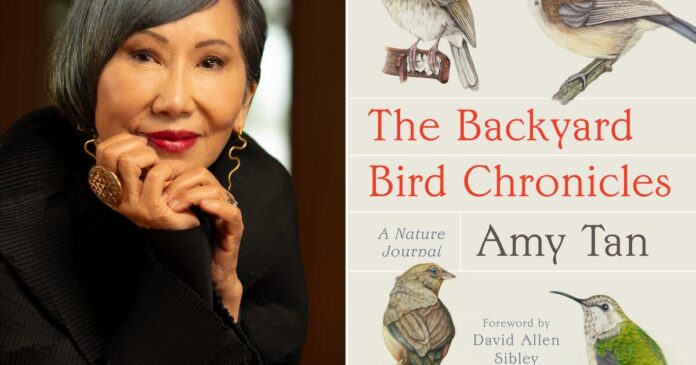Most of the drawings in Amy Tan’s unusual and rewarding new book, “The Backyard Bird Chronicles,” are of birds: birds at play, birds nibbling. Her book pulls from six years of journal entries about watching and studying birds in her backyard in Sausalito. But one of the drawings is not like the others.
It is a pencil sketch of Tan’s own face, peering through binoculars. In front of her eyes are two big black lenses. “What birds see: owl eyes = death,” she writes in all caps, as a caption to her self-portrait. It is a clever perspective shift in a book full of such reversals.
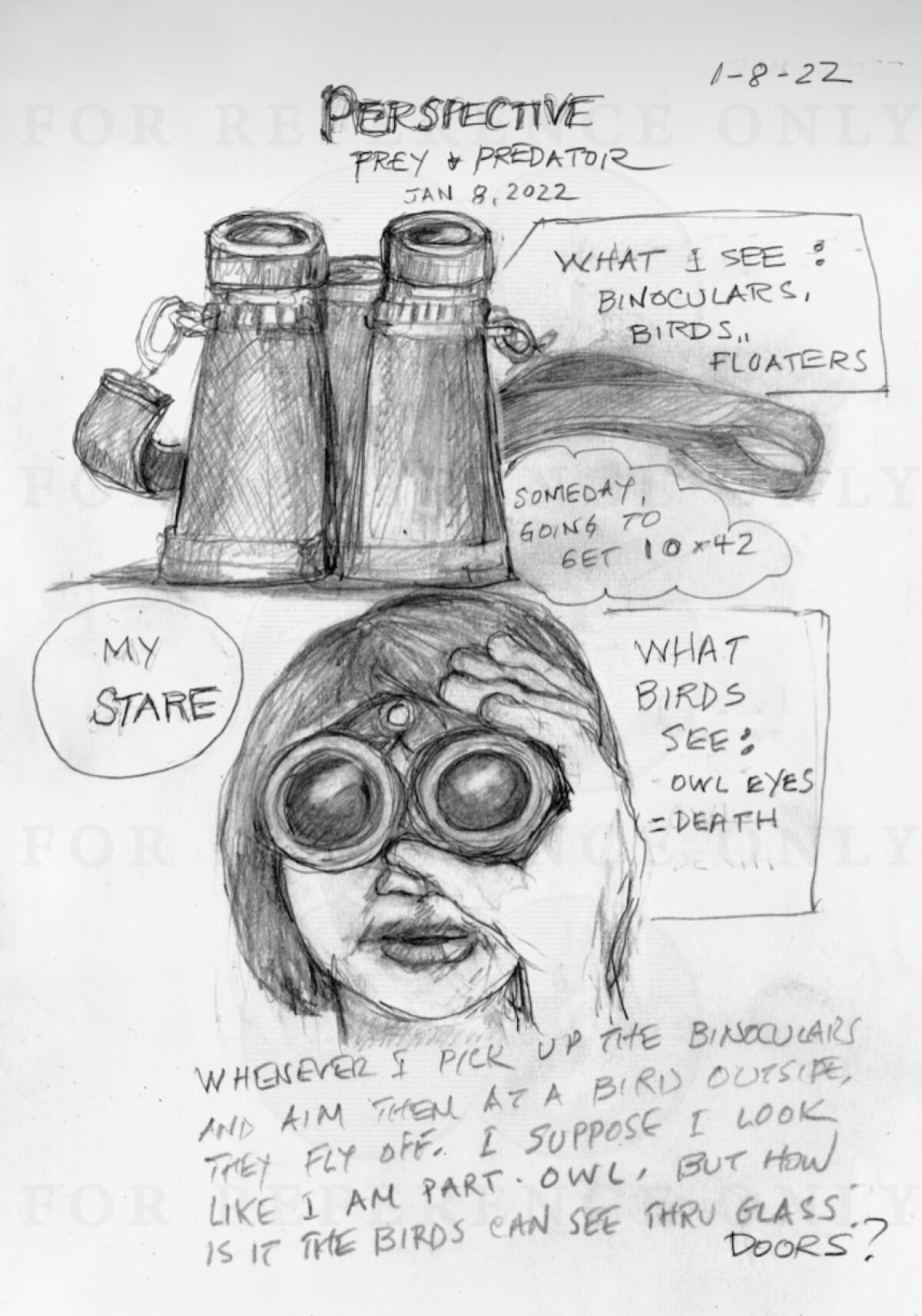
Amy Tan’s self-portrait of what she looks like to the birds she’s watching, in her new book “The Backyard Book Chronicles.”
(Courtesy of Random House.)
Tan is always wondering what the birds are seeing, feeling, thinking — about the world, about one another and about her, the quiet giant who feeds them and is always watching.
This is the book’s signature blend: ardent and undying curiosity, mixed with equal parts wit, courage and respect for her (flighty) subjects.
It may also be also some of Tan’s. The first of her seven novels, “The Joy Luck Club,” hit a nerve with readers for its unflinching portrayal of the lives of two generations of women living and dying in two continents — and became an international bestseller. She’s since written a screenplay, children’s books, more novels, several nonfiction books and has a novel in progress.
“The Backyard Bird Chronicles” is an unusual book because it’s sui generis — it’s Amy Tan’s unique take on drawing birds and reflecting on nature, survival and the state of the world. It’s made up of vignettes, a page or two long, plus her animal sketches and drawings, which improve astoundingly over the six years.
In someone else’s hands, this roughly 300-page book might have been a field guide or birding companion: workhorses for the serious hobbyist. But in Tan’s, it’s lithe, funny and never predictable.
There’s rivalry and loyalty. Love triangles and scheming. Ingenues, divas and towering villains. Even a burnt out mom. The cast: hummingbirds, owls, juncos, finches, crows, a menacing hawk, cheeky rodents and more.
The wider world also filters in: the COVID-19 pandemic and the isolation it wrought, plus wildfires, anti-Asian racism and the death of a friend.
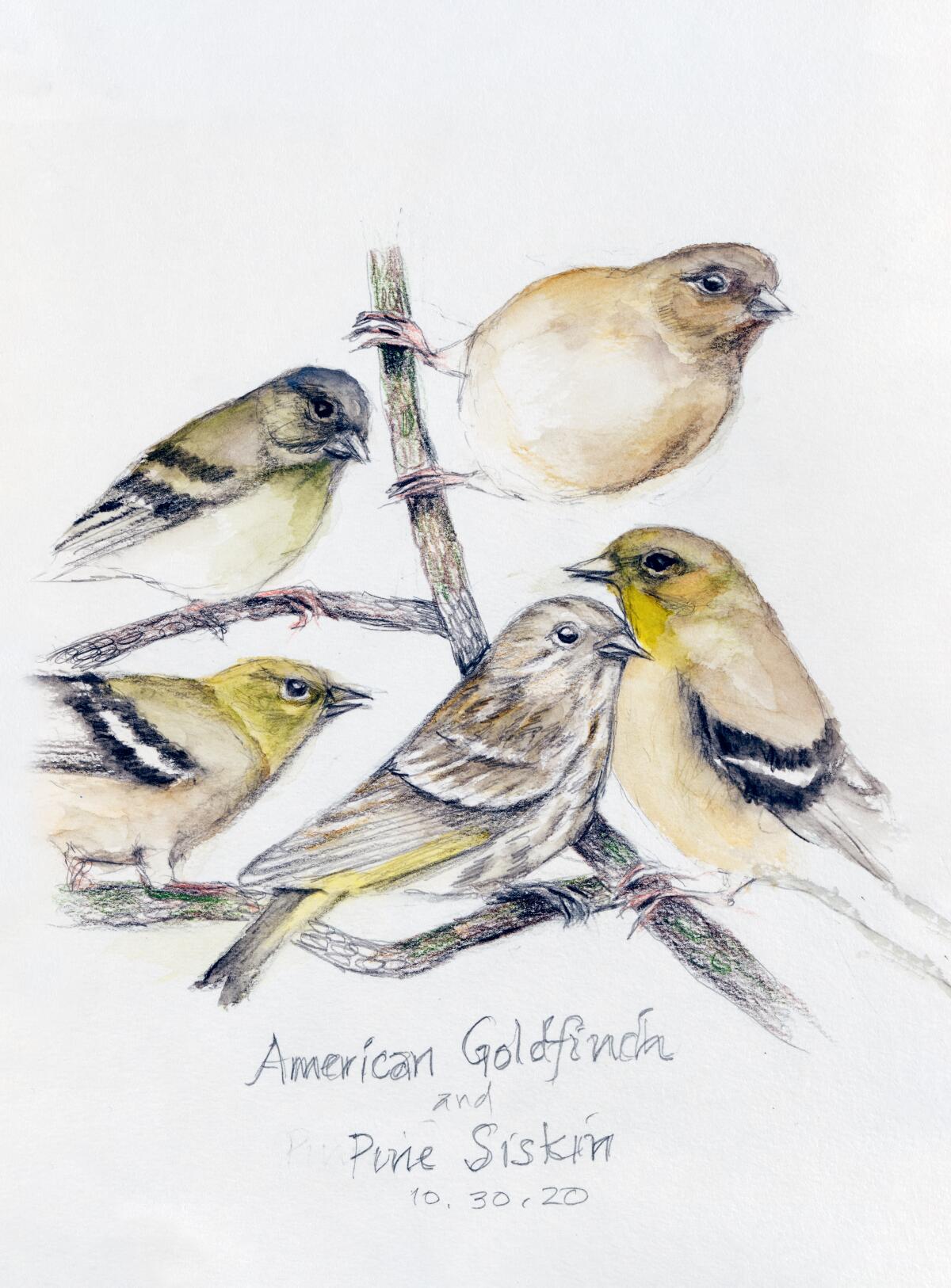
Drawings of different bird species by author-illustrator Amy Tan for her new book “The Backyard Bird Chronicles.”
(Amy Tan © 2024. All other rights reserved.)
This book was not meant for us. In an interview last week, Tan explained that she started journaling “really for myself, to find a sense of calm at a time that was very divisive in our country, and that really was upsetting — to the point it occupied my mind a lot. And I decided I needed to do something to reset my brain.”
It only became a book because her editor at Knopf, Daniel Halpern, coaxed her. “I said, ‘No, you don’t know what this really is. It’s messy. It’s, it’s got misspellings, you know, it’s all over the place.’ And he said, ‘No, I think we can do that, and the mess is authentic,’ ” Tan said.
It’s actually happened once before: Halpern also convinced her to write “Where the Past Begins,” a memoir that poet and essayist Mary Carr compared to Vladimir Nabokov’s “Speak, Memory.” Tan told a reporter in 2017, “I wrote this in a fugue state, not realizing what I was writing. It wasn’t until I was done that I became a little distressed and thought, wait a minute, this is going to be published?”
Even here, writing just for herself, Tan uses her writer’s eye to find dramas in every cranny of her leafy backyard. She’s not counting species and checking names off a list. The drawings aren’t all formal studies — quite the opposite. The sketches are cartoonish. And the birds are full-fledged characters.
Some of this was inspired by her nature journaling teacher, John Muir Laws, one of the people named in the book’s dedication. He taught her to “feel the life force of the bird,” Tan said.
“I took it a step further, being a fiction writer, and it was to ‘be the bird.’ And that way I would experience — try to experience — in my imagination, what it’s like to be a bird. Because everything that birds do, practically everything, is geared towards survival. … And so I get to see it through their eyes what they need to do.”
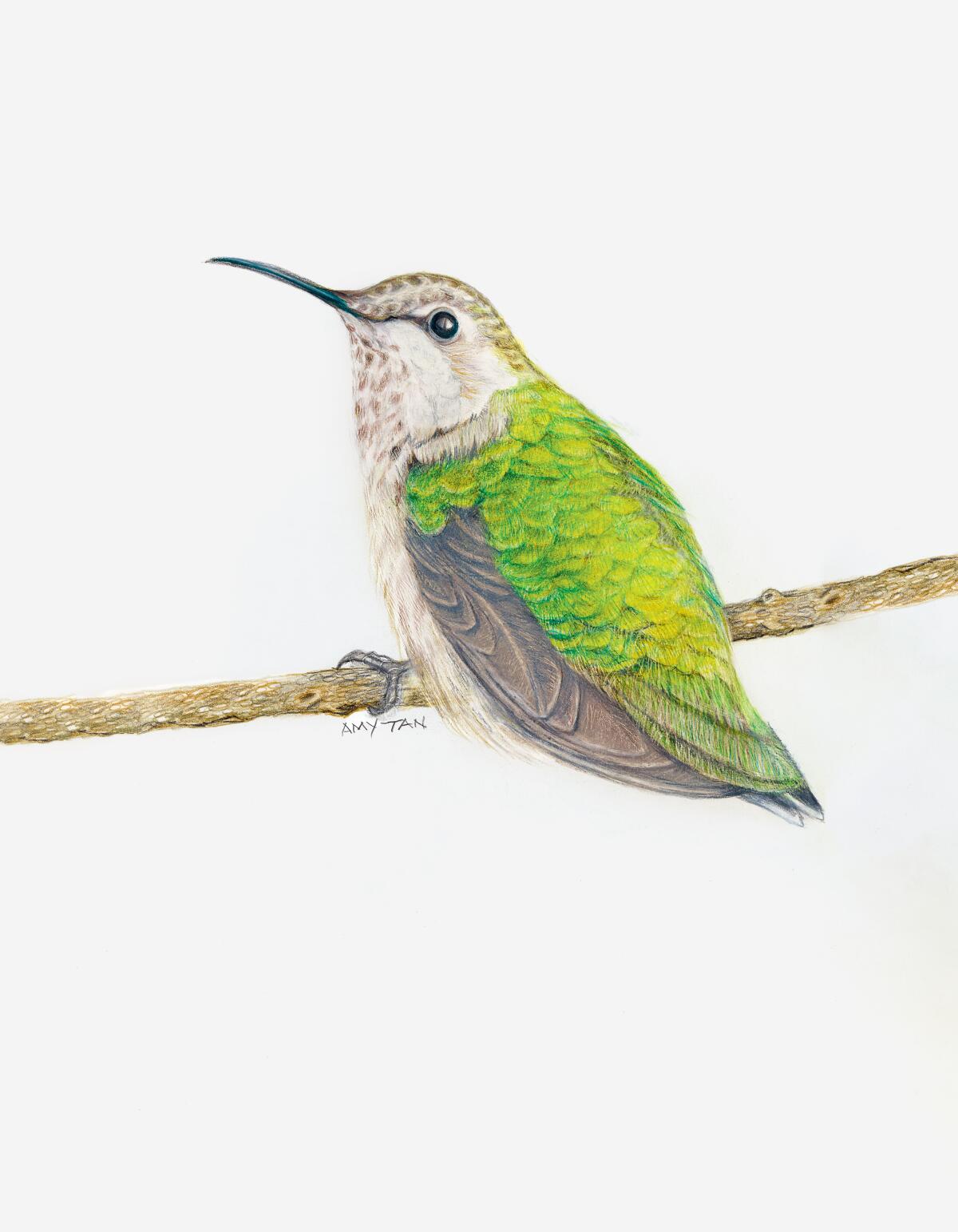
Author Amy Tan’s drawing of a hummingbird in her new book “The Backyard Book Chronicles.”
(Amy Tan © 2024. All other rights reserved.)
Tan knows she is not a scientist, and in the book she often jokes about how she’s doing things in a non-science way. She gives the birds human attributes. She talks to them. She answers for them. She loves them.
Did being a writer and embracing that part of her — imagination, humor and emotion — help her ask better questions or tune in better or differently?
“Absolutely,” Tan answered.
Some of what she wonders: “Has anyone followed one-legged migratory birds for a year to see if they survive?” “What kind of cognitive skills would a crow possess to experience embarrassment?” and “At what point do fledglings learn they are not the center of the world?”
This isn’t just the story of birds. It’s also the story of what can happen when you open your eyes and start noticing what’s around you.
In a dense but brief interview — her voice was worn out from talking on a book and birding tour — Tan said she hopes the book will inspire readers to do the same.
“I think that many, many people are seeking some kind of peace within themselves or they need to de-stress. They need to feel they are in control of their lives when things are falling apart. And nature offers that place where they can find themselves, be restored, or find refuge from stress. It’s there and it’s free,” she said.
She also hopes readers will “get into conservation somehow, whether it is making sure that window collisions don’t happen, or advocating that outdoor cats be brought indoors, and maybe even getting involved with a conservation organization devoted to birds.”
Asked if Tan has changed over the decades, her longtime agent, Sandra Dijkstra, who has represented the author since “The Joy Luck Club,” replied in an email: “Not in my view! Amy has just grown wiser over the years, even as she has maintained her wicked sense of humor and fun, too.”
Dijkstra added: “What is truly unique and powerful for me in Amy’s new book, ‘Backyard Bird Chronicles,’ is that it offers us a novelist’s perspective on the avian world: As Amy sees and interacts with them each, these birds become like ‘characters’ in her novels. And, at its heart, ‘Backyard’ is a book about love, which we sorely need in today’s crazy world.”
Tan doesn’t know if nature journaling and bird watching will filter into her creative writing.
“I’ve spent so many years now, thousands and thousands of hours on this. I think to myself, Well, how could it not seep in, you know? And then I would have the excuse to continue to watch birds every day.”
Tan described fiction writing, as she does it, as much more vulnerable than the type of personal, narrative nonfiction that appears in her journals.
“There are parts of myself that are very deep, that I only find through writing fiction. And it makes me vulnerable also, when it’s about to be published, and now this very private side of me is going to be shared,” Tan said. “People reading the book would not recognize that that is a discovery in myself. They will just see it as part of the story or part of the character. However, I dig very, very deep in emotions in my novels.”
Journaling, you can keep doing and doing. Fiction feels more fragile.
“The recognition, the realizations that happen in fiction can be so shocking and so gratifying that you want to keep doing it,” she said. “But at the same time, you’re afraid you’re going to lose it — whatever it is that enables you to write fiction. So, this skill, this focus, this ability to create a story might suddenly abandon you: it is the fear of, I think, almost every writer.”
Has Tan ever felt that way?
“I feel that way at the end of writing a book. I’m completely drained. And then when I have to start again, I feel that maybe I don’t have it in me anymore. And then I begin. I have to get over that, and then I just start. So get over yourself. Just begin,” she said.
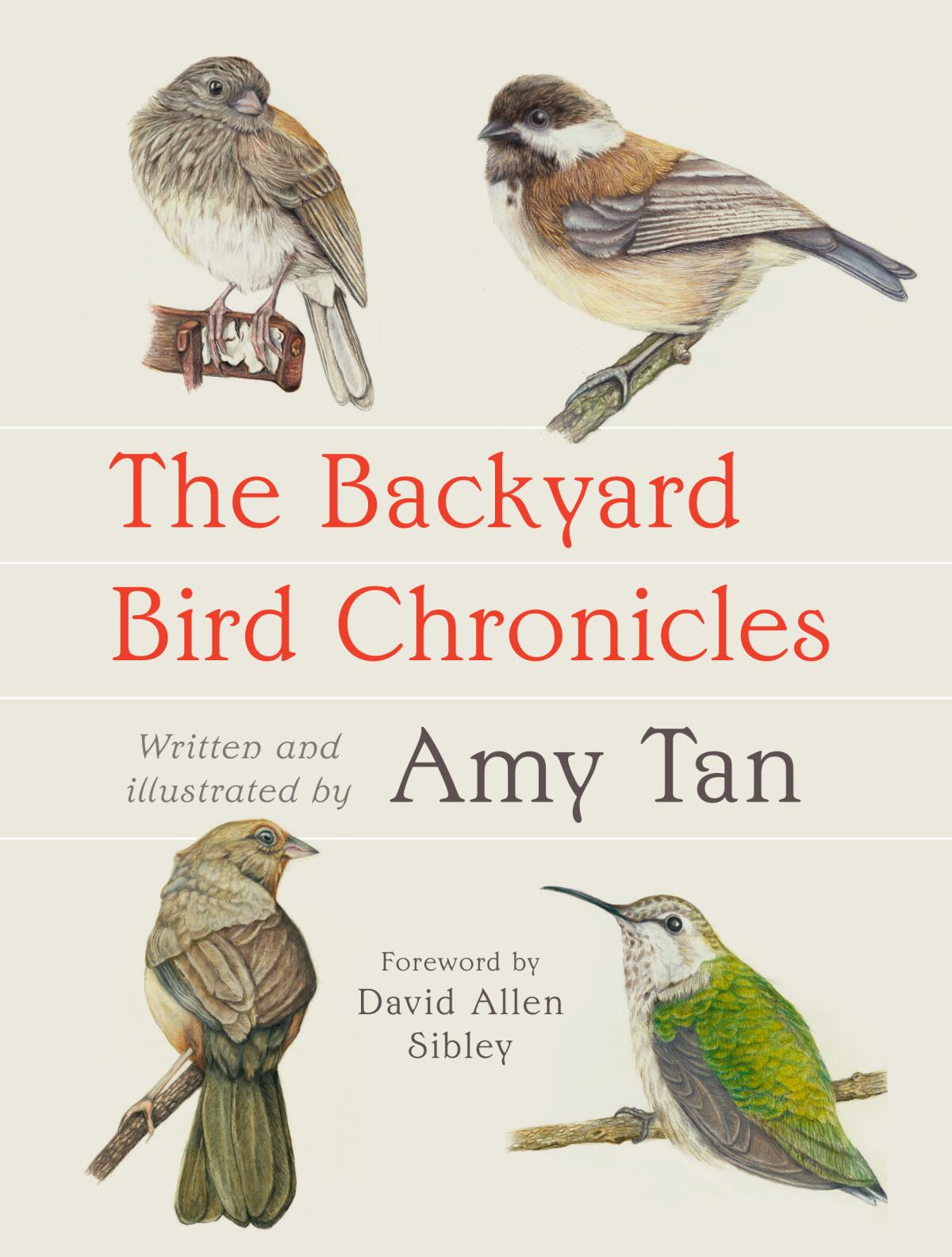
Book jacket for Amy Tan’s “The Backyard Book Chronicles.”
(Courtesy of Random House)
“The Backyard Book Chronicles” by Amy Tan (Knopf, 2024; 320 pages)
Warwick’s and the University of San Diego present Amy Tan
When: 7 p.m. Wednesday
Where: IPJ Theatre, Joan B. Kroc Institute for Peace and Justice, USD, 5555 Marian Way, San Diego
Tickets: $40.66 (includes signed copy of book)
Online: warwicks.com/event/tan-2024


